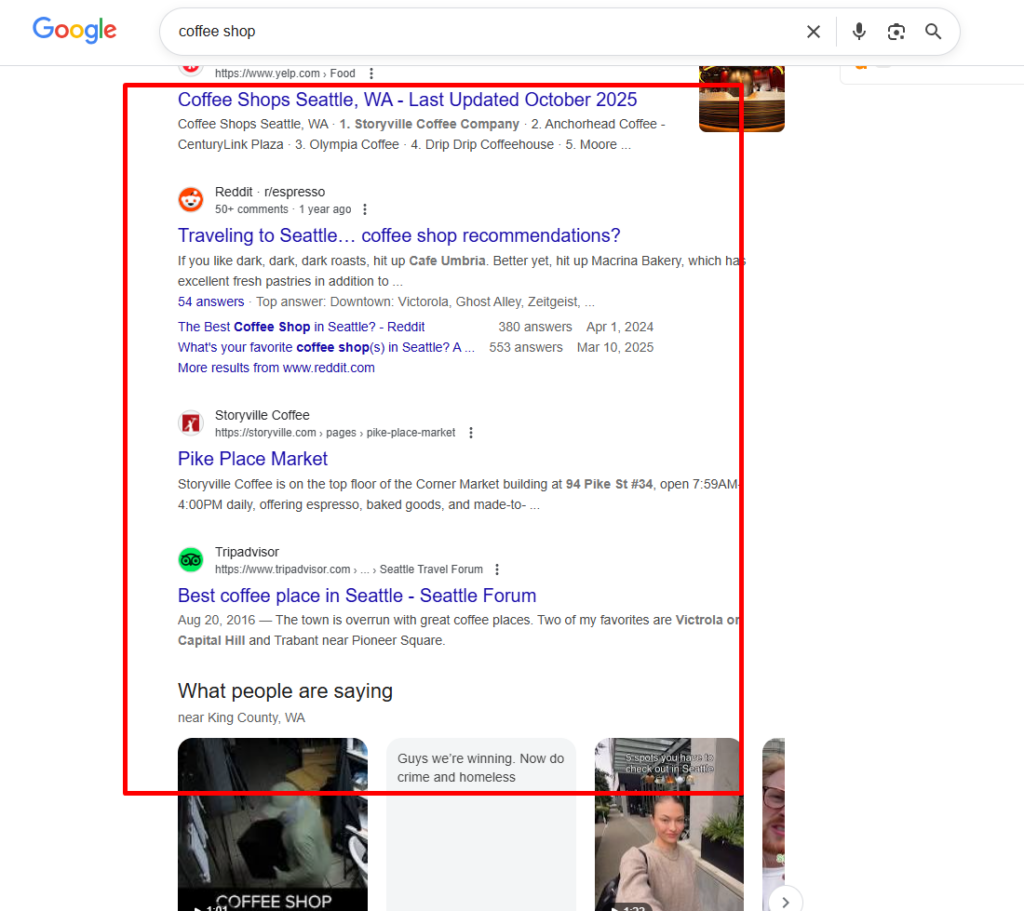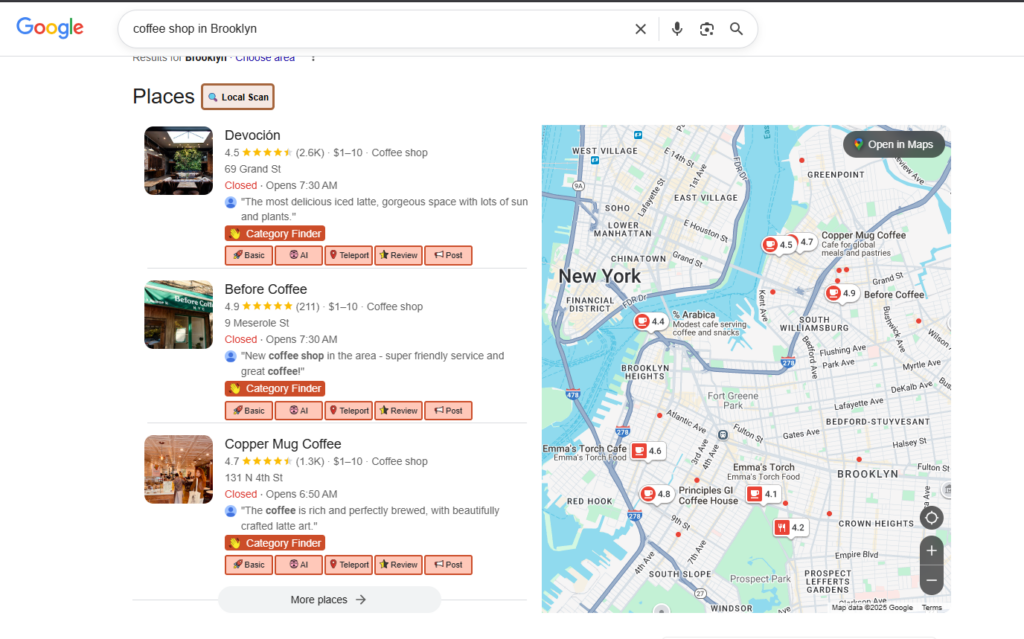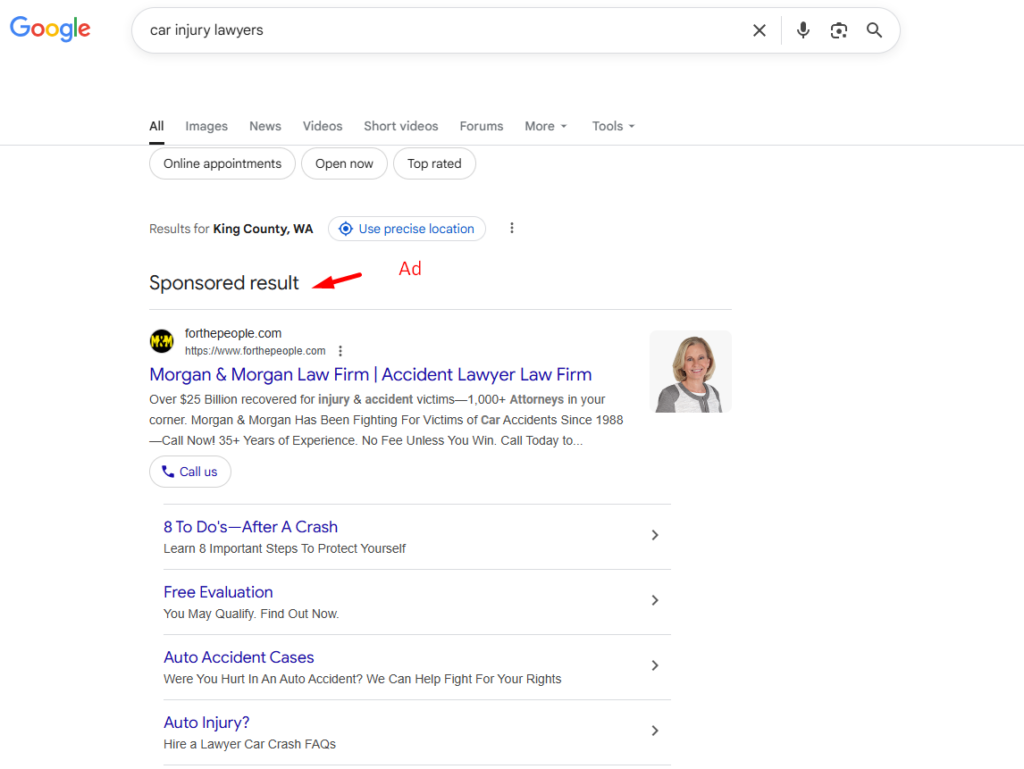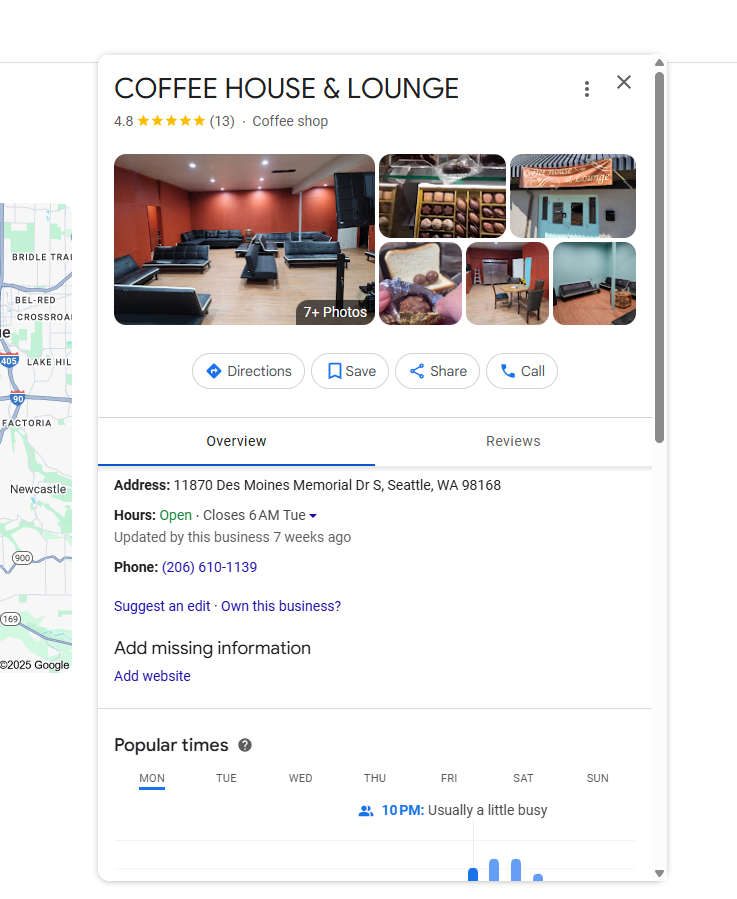You’re losing customers right now. Not because your service sucks. Not because your prices are too high. But because when someone in your neighborhood types “plumber near me” or “best Italian restaurant in [your city]” into Google, your business doesn’t show up.
Here’s what you didn’t know: 46% of all Google searches have local intent.
That’s nearly half of every single search happening right now. And if you’re not visible in those searches, you’re handing customers to your competitors on a silver platter.
Let me show you exactly how local SEO works—and more importantly, how you can use it to dominate your market.
Why This Matters for Your Business
Every day, potential customers are searching for exactly what you offer. They’re ready to buy. They’re in your area. They have their credit cards out.
But here’s what’s happening: 76% of people who search for something nearby visit a business within 24 hours. And 28% of those local searches result in a purchase.
Think about that for a sec…
If 100 people in your area search for your service today, 76 of them will visit a business tomorrow.
The question isn’t whether local search works—it’s whether they’re visiting YOUR business or your competitor’s.
This is where strategic local SEO services come in. It’s not about gaming the system. It’s about making sure Google understands what you do, where you are, and why you’re the best option when someone nearby needs your service.
What Local SEO Actually Is (And Why It’s Different)
Local SEO is the process of optimizing your online presence to attract customers from local search.
But here’s what most business owners get wrong: local SEO isn’t regular SEO with your city name thrown in.
When someone searches for “coffee shop,” Google shows them national chains and articles about coffee.

But when someone searches “coffee shop near me” or “coffee shop in Brooklyn,” Google completely changes the game.

It activates a different set of ranking signals specifically designed to show local businesses.
The difference? Local search results look like this:
- Google Map Pack (the top 3 businesses with a map)
- Local organic results (websites optimized for local search)
- Google Business Profile panels (the information box that shows up on the right)
Regular SEO focuses on ranking your website. Local SEO focuses on dominating all three of these areas simultaneously.
How Does Local SEO Work? The Three-Factor Framework
Google uses three main factors to decide which local businesses to show. Master these, and you control who sees your business.
1. Relevance: Does Your Business Match What They’re Searching For?
This is Google’s way of asking: “Is this business actually what the searcher needs?”
What Google looks at:
- Your business category (e.g., “Italian Restaurant” not just “Restaurant”)
- Your service descriptions
- Keywords in your Google Business Profile
- Content on your website
Here’s an example: A restaurant in Chicago that lists itself as “Pizza Restaurant” will show up for “pizza near me” but not “Italian food near me”—even if they serve pasta. The category matters more than you think.
The fix: Be specific about what you offer. Don’t try to be everything to everyone. If you’re a personal injury lawyer, don’t list yourself as a general attorney. Specificity wins.
2. Distance: How Close Are You to the Searcher?
This one’s simple: Google prioritizes businesses closest to the person searching.
When someone searches “restaurants near me,” Google checks their location and shows the closest options first. This is why you might rank #1 in one neighborhood but not appear at all three miles away.
Here’s what affects distance:
- Your actual physical location
- Whether the searcher included a location in their search (e.g., “dentist in Manhattan”)
- The searcher’s IP address or GPS location
The reality: You can’t change where your business is located. But you CAN optimize for the areas you serve by creating location-specific content and service area pages on your website.
3. Prominence: How Well-Known and Trusted Is Your Business?
This is where most local businesses drop the ball. Prominence is Google’s way of measuring your reputation and authority.
Google determines prominence through:
- Number and quality of reviews (Google, Yelp, industry-specific sites)
- Mentions of your business name, address, and phone number (NAP) across the web
- Backlinks from local websites and directories
- Social media signals
- How complete your Google Business Profile is
The stats don’t lie: Businesses with complete Google Business Profiles are 2.7 times more likely to be considered trustworthy by consumers. And verified businesses get over 21,643 views per year just from Google searches.
Read also: How to Start Doing Local SEO from Scratch
The Local Search: What You’re Actually Competing For
When someone searches for a local service, here’s what they see on their screen (in order):

- Google Ads (paid)
- Google Map Pack (the three-pack—this is prime real estate)
- People Also Ask questions (opportunity for content)
- Local organic results (traditional website rankings)

Here’s the thing: Research shows that organic results still get the most clicks, even with ads at the top. But the Map Pack businesses capture customers who are ready to buy RIGHT NOW.
80% of local searches result in conversions. These aren’t people browsing—they’re people buying.
Breaking Down the Google Business Profile: Your Most Powerful Asset
Your Google Business Profile (formerly Google My Business) is the foundation of local SEO.

Period.
Why it matters: When someone searches for your business or a service you provide, your Google Business Profile can appear in:
- Google Search results
- Google Maps
- The Local Map Pack
- Knowledge Panels
What you need to optimize:
Business Information (Non-Negotiable):

- Exact business name
- Complete address
- Phone number (use a local number, not an 800 number)
- Website URL
- Business category (primary and secondary)
- Service areas
- Hours of operation (including special hours for holidays)
Visual Assets:

- Cover photo
- Logo
- Interior/exterior photos
- Product/service photos
- Team photos
- Work examples (before/after for contractors, dishes for restaurants)
Active Engagement:
- Regular posts (weekly minimum)
- Q&A section (answer common questions proactively)
- Reviews and responses (respond to EVERY review, good or bad)
Let me give you an example.
We’ve been working with a roofing contractor in Dallas. We started posting weekly project updates with before/after photos on their Google Business Profile.
They answered the 10 most common questions in the Q&A section.
Result?
Their profile views increased 340% in 90 days, and phone calls jumped 67%.
The “Near Me” Secret: Why Mobile Search Changed Everything
Remember when people used phone books?
Now 64% of small businesses have a local SEO presence, but that number should be 100%.
Here’s why:
“Near me” searches have exploded:
- Over 1.5 billion “near me” searches happen monthly
- “Open now near me” searches are up 400%
- “Where to buy near me” searches grew 200% in two years
The mobile reality: 88% of people who do a local search on their smartphone visit or call a business within 24 hours.
That’s not a typo. Nearly 9 out of 10 mobile local searches result in a visit or phone call THE SAME DAY.
What this means for you: If your business isn’t optimized for mobile search, you’re missing almost 90% of the people who are ready to buy from you right now.
Citations and NAP: This is the Consistency That Builds Trust
A citation is any online mention of your business name, address, and phone number.
These are the digital references that tell Google “yes, this business is real and located here.”
Where citations matter:
- Business directories (Yelp, Yellow Pages, BBB)
- Industry-specific directories
- Local chamber of commerce websites
- News mentions
- Blog posts
The golden rule: NAP consistency is everything.
If your website says “123 Main Street” but Yelp says “123 Main St” and another directory says “123 Main Street, Suite A”—Google gets confused.
And guess what?
Confused Google = lower rankings.
The fix: Use the exact same format for your business name, address, and phone number everywhere it appears online. Character for character. Comma for comma.
Reviews: The Social Proof That Drives Rankings AND Conversions
Let’s talk numbers: 93% of consumers say online reviews affect their buying decisions. And 72% of consumers say positive reviews make them trust a local business more.
But here’s what most businesses don’t know: Reviews aren’t just for customers—they’re ranking signals for Google.
How reviews impact local SEO:
- Quantity of reviews
- Frequency of new reviews
- Star rating average
- Review content (keywords in reviews matter)
- Responses to reviews
A dental practice in Phoenix implemented a simple review request system: Ask happy patients to leave a review before they leave the office. Within 6 months, they went from 12 reviews to 147 reviews. They jumped from position #7 to #2 in the Map Pack for “dentist near me.”
The system that works:
- Ask for reviews immediately after a positive experience
- Make it dead simple (send a direct link via text or email)
- Respond to every review within 24-48 hours
- Never, ever buy fake reviews (Google will catch you and destroy your rankings)
Local Content Strategy: How to Dominate “People Also Ask”
When you search for local services, you’ll often see a “People Also Ask” section. This is gold for local SEO because it tells you exactly what questions your customers are asking.
The strategy: Create content that answers these questions better than anyone else.
Example for a plumber:
- “How much does it cost to fix a leaky faucet?”
- “What causes low water pressure?”
- “How do I know if I need a new water heater?”
Pro tip: Use these questions as blog post titles, FAQ sections on your website, and posts on your Google Business Profile. When your content directly answers searcher questions, Google rewards you with higher visibility.
According to SEO professionals working with local businesses, creating monthly blog posts that answer “People Also Ask” questions has directly improved rankings and increased organic traffic by 40-60% for their clients.
Local Link Building (The Authority Multiplier)
Links from other websites to your website tell Google “this business is important and trustworthy.”
Local link opportunities that actually work:
Community involvement:
- Local chamber of commerce
- Business associations
- Sponsoring local events
- Local news coverage
- Community organizations
Industry-specific:
- Local trade associations
- Industry directories
- Supplier websites
- Partnership opportunities
Content-based:
- Guest posting on local blogs
- Local resource guides
- Being quoted in local news stories
- Creating shareable local content (local guides, statistics, studies)
A home remodeling company in Austin sponsored a local Little League team. They got a link from the league website, were mentioned in local news coverage, and appeared on the city’s community sponsors page. Those three links helped them rank #1 for “home remodeling Austin” within 4 months.
Website Optimization for Local Search (What You Need To Know)
Your website needs to speak Google’s language when it comes to local search.
Location signals on your website:
- City/state in title tags and meta descriptions
- Location-specific pages for each service area
- Embedded Google Map on your contact page
- Schema markup (local business structured data)
- Location keywords in headers and content
- Footer with complete NAP information
Mobile optimization is non-negotiable: 60% of mobile users prefer contacting businesses with mobile-optimized sites. If your site doesn’t work perfectly on phones, you’re losing 6 out of 10 potential customers before they even call you.
Site speed matters: 78% of local mobile searches result in offline purchases. But if your site takes 5 seconds to load, most people will click back and choose your competitor instead.
Common Local SEO Mistakes That Kill Your Rankings
Let me save you months of frustration. Here’s what NOT to do:
1. Keyword stuffing your business name
- Wrong: “Joe’s Pizza – Best Pizza NYC Pizza Restaurant New York”
- Right: “Joe’s Pizza”
2. Inconsistent NAP across platforms
- Pick one format and stick with it everywhere
3. Ignoring negative reviews
- Respond to every review. Every single one. Even the nasty ones (especially the nasty ones)
4. Using a P.O. Box instead of a physical address
- Google wants to see real business locations
5. Buying reviews or fake citations
- Google will catch you and tank your rankings permanently
6. Setting “store hours” then closing early
- Update your hours in real-time. Nothing frustrates customers more than showing up to a “closed” business that Google said was open
7. Not monitoring your Google Business Profile
- Check it daily. Answer questions. Respond to reviews. Post updates.
Local SEO Time and Cost
Let’s address the elephant in the room: How long does this take, and what does it cost?
Timeline expectations:
- Month 1-2: Set up and optimization (Google Business Profile, citations, website basics)
- Month 3-4: You’ll start seeing movement in rankings
- Month 6: Significant improvements in visibility and traffic
- Month 12+: Dominant market position if you stay consistent
The average time to rank: On average, top-ranking pages have been around for over 2.5 years. This is a marathon, not a sprint.
DIY cost: $500-$2,000/month in time and tools if you do it yourself
Professional cost: $1,000-$5,000/month for comprehensive local SEO service from an agency. Lucky for you, you don’t even need half of that to get started with us.
How about the ROI?
If one new customer is worth $1,000 to your business, you only need 2-3 new customers per month to 10x your investment.
Most businesses see 5-20+ new customers monthly from local SEO.
How To Measure Local SEO Success (This Is What Actually Matters)
Forget vanity metrics. Here’s what you should track:
Google Business Profile metrics:
- Profile views
- Search queries (how people found you)
- Website clicks
- Direction requests
- Phone calls
Website metrics:
- Organic traffic from local searches
- Local keyword rankings
- Conversion rate from local traffic
- Pages per session
- Bounce rate
Business metrics (the ones that actually matter):
- Phone calls from local search
- Form submissions
- In-store visits
- Revenue from local SEO traffic
Real benchmark: A well-optimized local business should see a 15-30% increase in local search traffic within 6 months and a 40-100% increase within 12 months.
Your Next Steps: The 30-Day Local SEO Sprint
Here’s exactly what to do in the next 30 days to start dominating local search:
Week 1: Foundation
- Claim and verify your Google Business Profile
- Audit your NAP consistency across all platforms
- Complete 100% of your Google Business Profile (every field, every section)
- Add 10+ high-quality photos
Week 2: Reviews and Reputation
- Set up a review request system
- Respond to all existing reviews
- Ask your 10 best customers for reviews
- Create a Q&A section with 10 common questions answered
Week 3: Citations and Listings
- Get listed on top 10 directories (Yelp, Yellow Pages, BBB, etc.)
- Ensure NAP consistency everywhere
- Submit to industry-specific directories
Week 4: Content and Optimization
- Update website with location keywords in titles and headers
- Create or update your location/service area pages
- Write one blog post answering a common customer question
- Add schema markup to your website
The bottom line: Local SEO isn’t magic. It’s a system. Follow the system, stay consistent, and you’ll dominate your market.
Why Most Local Businesses Fail at This
Here’s the uncomfortable truth: 58% of companies still don’t optimize for local search even though they know it works.
Why? Three reasons:
- They think it’s too complicated (it’s not—you just need a clear system)
- They want instant results (local SEO takes 3-6 months to gain serious traction)
- They try to do everything at once (start with the fundamentals and expand)
The businesses that win at local SEO aren’t necessarily smarter or better funded. They’re just more consistent. They show up every week. They optimize every month. They never stop.
Ready to Own Your Local Market?
You have two options:
Option 1: Spend the next 6-12 months learning, implementing, testing, and optimizing local SEO yourself. It’s possible. Plenty of business owners do it. But it will cost you time—time you could spend running your business.
Option 2: Work with professionals who do this every day for dozens of clients and know exactly what works.
If you’re ready to stop losing customers to competitors who show up higher in local search, it’s time to get serious about local SEO services that deliver measurable results.
The best time to start local SEO was a year ago. The second best time is today.
Because right now, while you’re reading this, someone in your area is searching for exactly what you offer. The question is: Will they find you or your competitor?
Want to see where you stand? Most comprehensive local SEO strategies start with an audit of your current online presence. Use our free GMP checker to discover the specific opportunities in your market and get a roadmap for dominating local search in your area.
Your competitors aren’t waiting.
Why should you?
Read also: